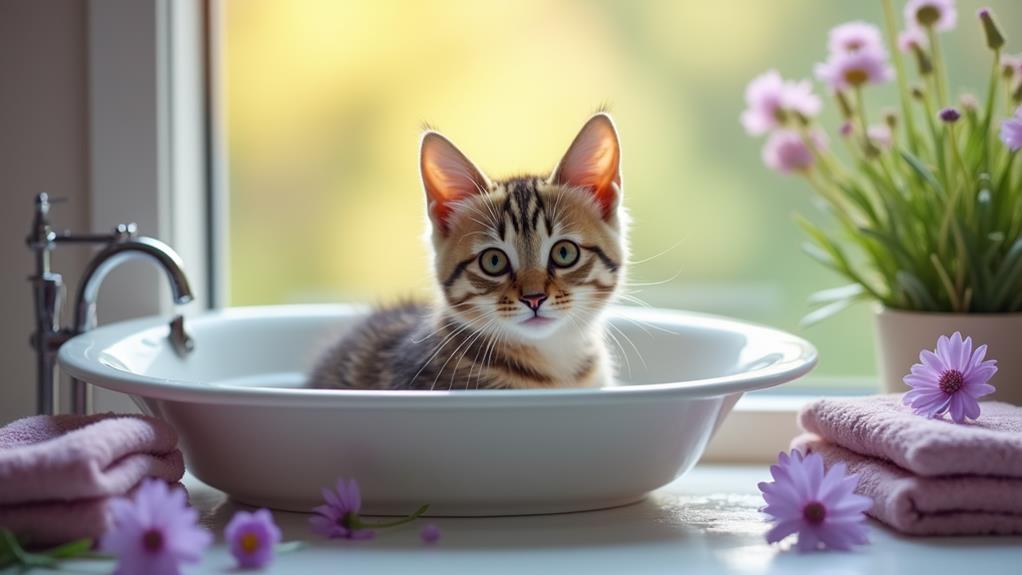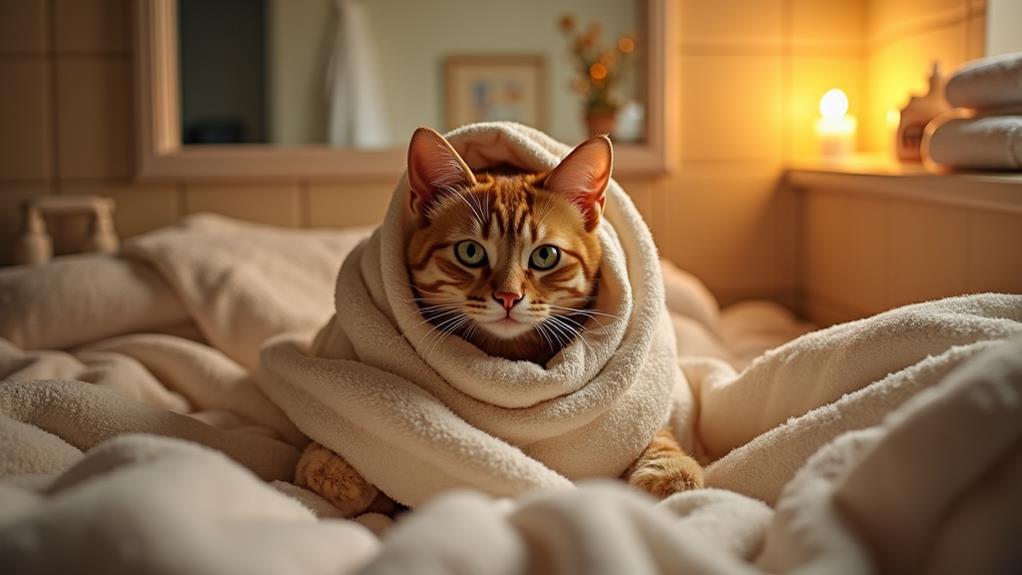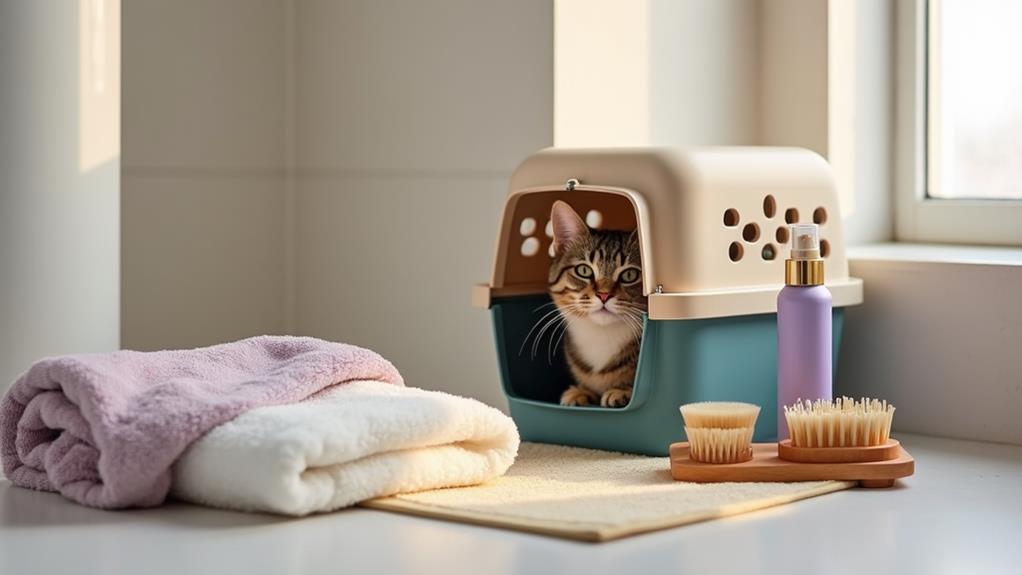How to Safely Give a Feral Cat a Bath: A Step-by-Step Guide

Bathing a feral cat safely needs careful preparation and a calm approach. Gather supplies like a cat-specific shampoo, towels, rubber gloves, a non-slip mat, and lukewarm water. Choose a quiet bathroom and let the cat investigate the area initially to reduce stress. Use a humane trap to capture the cat calmly and gently move it to the bathing area. Wet the cat slowly, apply shampoo avoiding the face, and rinse thoroughly. Once clean, wrap the cat in a towel to dry. For a more harmonious experience and to uncover alternative cleaning tips, follow this guidance.
Gather Necessary Supplies
Before you attempt to bathe a feral cat, it's crucial to gather the right supplies to guarantee safety and minimize stress for both you and the cat. Start with acquiring cat-specific shampoo. It's formulated to be gentle on a cat's sensitive skin, reducing the risk of irritation or allergic reactions. You don't want to use human shampoo, as it can be too harsh for them.
Next, make certain to have rubber gloves on hand. These will protect your hands from potential scratches and help you maintain a firm grip on the often-squirming feline. Another vital item is a non-slip mat. Place this in the bathing area to make sure the cat has stable footing, which can help them feel more secure during the process.
You'll also need several towels to dry your cat after the bath. Feral cats can become very wet and might need immediate wrapping post-rinsing. Speaking of rinsing your cat, have a small basin or bucket of warm water ready, especially if you don't have a spray hose. This will make certain you're rinsing with water that's comfortable for the cat. Gathering these bath supplies will make the task of bathing your cat more manageable.
Preparing the Bathing Area
To guarantee a smooth bathing experience for your feral cat, start by preparing a calm and secure bathing area. Choose a quiet, safe location like a bathroom or laundry room to minimize distractions and stress. Lay down a non-slip mat or towel in the bathing area to provide secure footing for your cat during the bath. This simple step prevents slipping and helps reduce anxiety. Make sure the area is warm and free from drafts, as feral cats are sensitive to temperature changes and may become stressed in a chilly environment.
Gather all necessary supplies within arm's reach to avoid leaving the cat unattended. You'll need cat shampoo, towels, a small basin or sink, and a bucket of lukewarm water for rinsing. Preparation is key to ensuring the bath goes smoothly without unnecessary interruptions.
Consider letting your feral cat investigate the bathing area beforehand. Familiarizing them with the space can greatly reduce anxiety when it's time for the actual bath. Remember, keeping the atmosphere calm and organized will help both you and your feral cat feel more at ease.
- Choose a quiet location like a bathroom.
- Use a non-slip mat for secure footing.
- Keep the area warm to prevent stress.
Approaching the Feral Cat

After preparing the bathing area, it's fundamental to approach the feral cat with care. Begin by moving slowly and calmly to avoid startling the cat, as sudden movements might provoke fear or aggression. Equip yourself with a humane trap, which is a safe and effective method to capture the feral cat. Verify the trap is properly baited with appealing food to encourage the cat's entry. As you near the trap, speak softly to the cat. This gentle communication helps create a sense of familiarity and can reduce its anxiety.
Wearing protective clothing is imperative during this process. Put on gloves and long sleeves to safeguard yourself from possible scratches or bites. Once the feral cat enters the trap, it's significant to allow it to acclimate to its new surroundings. Transfer the trapped cat to a secure environment that is quiet and free from disturbances. Providing this calm space before attempting any further handling is critical, as it minimizes stress and promotes a sense of safety for the cat. By following these steps, you'll guarantee a smoother and less stressful experience for both you and the feral cat.
Bathing Process Step-by-Step
Getting started with the bathing process involves setting up a safe and comfortable area where you can easily manage the feral cat. Use non-slip mats for stability, and prepare lukewarm water. Make certain all your supplies, like cat-specific shampoo, towels, and a wet washcloth, are within arm's reach. This setup minimizes stress and keeps bath time smooth for both you and the cat.
Before you begin, securely confine the cat in a small tub or sink. Gently wet the fur starting from the back, avoiding sudden movements that might startle it. Apply the cat-specific shampoo, massaging it gently from neck to tail. Be mindful of sensitive skin areas and avoid the face. For the head, a wet washcloth works best to clean without discomfort.
When it's time to rinse your cat, use lukewarm water to thoroughly remove all traces of shampoo. Pay extra attention to areas like the groin and armpits, where moisture tends to linger. After rinsing, use a towel to dry the cat by securely wrapping it, absorbing excess water effectively. This careful approach makes certain a safe and stress-free bath time for your feral friend.
- Make certain all supplies are ready
- Start wetting the cat gently
- Use a damp cloth for the head
Drying the Cat Safely

Once you've finished rinsing, it's crucial to dry the feral cat safely to prevent chills and discomfort. Begin by wrapping your cat in a soft absorbent towel immediately. This minimizes exposure to cold and helps absorb excess water. Gently pat the cat's fur with the towel instead of rubbing vigorously, which can cause stress or discomfort.
If the cat seems calm, you can try using a low-heat pet-specific hairdryer to dry your cat. Keep the dryer at a safe distance to avoid overheating and always monitor for signs of distress, such as excessive meowing or attempts to escape. Some feral cats may not tolerate the noise or sensation, so be ready to stop if the cat becomes anxious.
Ensure the drying area is warm and free from drafts. Temperature changes can be more challenging for feral cats compared to domesticated ones. Once you've removed much of the moisture, allow the cat to air dry in a quiet safe space. This gives the cat time to acclimate and recover from the experience. Providing a comfortable environment is key to guaranteeing the cat remains calm and begins to feel secure.
Post-Bath Care and Rewards
Bath time might be over, but your care for the feral cat continues. Post-bath care is vital to guarantee the cat's comfort and safety. Start by providing a warm and quiet space where the cat can recover. This helps alleviate any stress or anxiety it might have experienced during the bath. Allow the cat to dry naturally in this safe environment, as blow-drying can be quite stressful for them.
You'll want to monitor the cat closely for any signs of irritation or discomfort, like excessive grooming or hiding. This helps you verify the cat is adjusting well after the bath. Positive interactions are key, so offer treats or gentle praise to create a positive association with the bathing experience. This will help build trust over time.
Engaging in gentle interactions can reinforce a sense of safety and comfort. Consider offering a favorite toy or some calm, gentle petting.
Here's a quick checklist to guide your post-bath care:
- Provide a cozy, quiet space for drying and recovery.
- Monitor for any signs of discomfort to guarantee well-being.
- Use treats and praise to establish a positive association with bathing.
Alternative Cleaning Methods

Caring for a feral cat doesn't always mean you need to give it a full bath. Sometimes, alternative cleaning methods are more effective and less stressful for both you and the cat. If your cat resists water, try using dry cat shampoo. This product absorbs oils and dirt without rinsing, offering a quick and easy solution to keep your cat clean without the hassle of water exposure.
Pet grooming wipes are another excellent choice. They allow you to gently clean the cat's fur, removing dirt and maintaining hygiene without a full bath. This can be a more comfortable experience for the cat, minimizing anxiety and stress.
For specific dirty spots, consider spot cleaning with a damp cloth to clean localized areas. This method is effective for handling small messes while keeping the cat's comfort in mind. If you absolutely must introduce some water, use a spray bottle filled with warm water to lightly mist the cat, allowing for gradual wetting. This approach won't overwhelm them as much as a full bath might.




